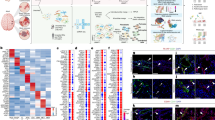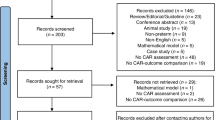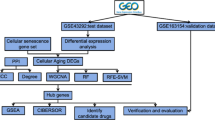Abstract
Background:
With development from immature fetus to near-term fetus, newborn, and adult, the cerebral vasculature undergoes a number of fundamental changes. Although the near-term fetus is prepared for a transition from an intra- to extra-uterine existence, this is not necessarily the case with the premature fetus, which is more susceptible to cerebrovascular dysregulation. In this study, we tested the hypothesis that the profound developmental and age-related differences in cerebral blood flow are associated with significant underlying changes in gene expression.
Methods:
With the use of oligonucleotide microarray and pathway analysis, we elucidated significant changes in the transcriptome with development in sheep carotid arteries.
Results:
As compared with adult, we demonstrate a U-shaped relationship of gene expression in major cerebrovascular network/pathways during early life, e.g., the level of gene expression in the premature fetus and newborn is considerably greater than that of the near-term fetus. Specifically, cell proliferation, growth, and assembly pathway genes were upregulated during early life. In turn, as compared with adult, mitogen-activated protein kinase–extracellular regulated kinase, actin cytoskeleton, and integrin-signaling pathways were downregulated during early life.
Conclusion:
In cranial vascular smooth muscle, highly significant changes occur in important cellular and signaling pathways with maturational development.
Similar content being viewed by others
Log in or create a free account to read this content
Gain free access to this article, as well as selected content from this journal and more on nature.com
or
References
Donnan GA, Fisher M, Macleod M, Davis SM . Stroke. Lancet 2008;371:1612–23.
Sheth RD . Trends in incidence and severity of intraventricular hemorrhage. J Child Neurol 1998;13:261–4.
Nelson KB . Can we prevent cerebral palsy? N Engl J Med 2003;349:1765–9.
Donegan JH, Traystman RJ, Koehler RC, Jones MD Jr, Rogers MC . Cerebrovascular hypoxic and autoregulatory responses during reduced brain metabolism. Am J Physiol 1985;249(2 Pt 2):H421–9.
Heistad DD, Marcus ML, Abboud FM . Role of large arteries in regulation of cerebral blood flow in dogs. J Clin Invest 1978;62:761–8.
Dieckhoff D, Kanzow E . [On the location of the flow resistance in the cerebral circulation]. Pflugers Arch 1969;310:75–85.
Kontos HA, Wei EP, Navari RM, Levasseur JE, Rosenblum WI, Patterson JL Jr . Responses of cerebral arteries and arterioles to acute hypotension and hypertension. Am J Physiol 1978;234:H371–83.
Bassan H . Intracranial hemorrhage in the preterm infant: understanding it, preventing it. Clin Perinatol 2009;36:737–62, v.
Ward Platt M, Deshpande S . Metabolic adaptation at birth. Semin Fetal Neonatal Med 2005;10:341–50.
Wagerle LC, Moliken W, Russo P . Nitric oxide and beta-adrenergic mechanisms modify contractile responses to norepinephrine in ovine fetal and newborn cerebral arteries. Pediatr Res 1995;38:237–42.
Goyal R, Mittal A, Chu N, Arthur RA, Zhang L, Longo LD . Maturation and long-term hypoxia-induced acclimatization responses in PKC-mediated signaling pathways in ovine cerebral arterial contractility. Am J Physiol Regul Integr Comp Physiol 2010;299:R1377–86.
Goyal R, Creel KD, Chavis E, Smith GD, Longo LD, Wilson SM . Maturation of intracellular calcium homeostasis in sheep pulmonary arterial smooth muscle cells. Am J Physiol Lung Cell Mol Physiol 2008;295:L905–14.
Goyal R, Mittal A, Chu N, Zhang L, Longo LD . alpha(1)-Adrenergic receptor subtype function in fetal and adult cerebral arteries. Am J Physiol Heart Circ Physiol 2010;298:H1797–806.
Szymonowicz W, Walker AM, Yu VY, Stewart ML, Cannata J, Cussen L . Regional cerebral blood flow after hemorrhagic hypotension in the preterm, near-term, and newborn lamb. Pediatr Res 1990;28:361–6.
LeClair R, Lindner V . The role of collagen triple helix repeat containing 1 in injured arteries, collagen expression, and transforming growth factor beta signaling. Trends Cardiovasc Med 2007;17:202–5.
Tang L, Dai DL, Su M, Martinka M, Li G, Zhou Y . Aberrant expression of collagen triple helix repeat containing 1 in human solid cancers. Clin Cancer Res 2006;12:3716–22.
Goyal R, Henderson DA, Chu N, Longo LD . Ovine middle cerebral artery characterization and quantification of ultrastructure and other features: changes with development. Am J Physiol Regul Integr Comp Physiol 2012;302:R433–45.
Faraci FM, Didion SP . Vascular protection: superoxide dismutase isoforms in the vessel wall. Arterioscler Thromb Vasc Biol 2004;24:1367–73.
Carvajal RD, Tse A, Schwartz GK . Aurora kinases: new targets for cancer therapy. Clin Cancer Res 2006;12:6869–75.
McClellan WJ, Dai Y, Abad-Zapatero C, et al. Discovery of potent and selective thienopyrimidine inhibitors of Aurora kinases. Bioorg Med Chem Lett 2011;21:5620–4.
Skibbens RV, Hieter P . Kinetochores and the checkpoint mechanism that monitors for defects in the chromosome segregation machinery. Annu Rev Genet 1998;32:307–37.
van Ree JH, Jeganathan KB, Malureanu L, van Deursen JM . Overexpression of the E2 ubiquitin-conjugating enzyme UbcH10 causes chromosome missegregation and tumor formation. J Cell Biol 2010;188:83–100.
Kuriyama M, Taniguchi T, Shirai Y, Sasaki A, Yoshimura A, Saito N . Activation and translocation of PKCdelta is necessary for VEGF-induced ERK activation through KDR in HEK293T cells. Biochem Biophys Res Commun 2004;325:843–51.
Mazzucchelli C, Vantaggiato C, Ciamei A, et al. Knockout of ERK1 MAP kinase enhances synaptic plasticity in the striatum and facilitates striatal-mediated learning and memory. Neuron 2002;34:807–20.
Bost F, Aouadi M, Caron L, et al. The extracellular signal-regulated kinase isoform ERK1 is specifically required for in vitro and in vivo adipogenesis. Diabetes 2005;54:402–11.
Lampard GR, Lukowitz W, Ellis BE, Bergmann DC . Novel and expanded roles for MAPK signaling in Arabidopsis stomatal cell fate revealed by cell type-specific manipulations. Plant Cell 2009;21:3506–17.
Goyal R, Mittal A, Chu N, Shi L, Zhang L, Longo LD . Maturation and the role of PKC-mediated contractility in ovine cerebral arteries. Am J Physiol Heart Circ Physiol 2009;297:H2242–52.
Feng Y, Walsh CA . The many faces of filamin: a versatile molecular scaffold for cell motility and signalling. Nat Cell Biol 2004;6:1034–8.
Sheen VL, Feng Y, Graham D, Takafuta T, Shapiro SS, Walsh CA . Filamin A and Filamin B are co-expressed within neurons during periods of neuronal migration and can physically interact. Hum Mol Genet 2002;11:2845–54.
Staus DP, Blaker AL, Medlin MD, Taylor JM, Mack CP . Formin homology domain-containing protein 1 regulates smooth muscle cell phenotype. Arterioscler Thromb Vasc Biol 2011;31:360–7.
Schmidt A, Hall MN . Signaling to the actin cytoskeleton. Annu Rev Cell Dev Biol 1998;14:305–38.
Campbell ID, Humphries MJ . Integrin structure, activation, and interactions. Cold Spring Harb Perspect Biol 2011;3:1–14.
Suen PW, Ilic D, Caveggion E, Berton G, Damsky CH, Lowell CA . Impaired integrin-mediated signal transduction, altered cytoskeletal structure and reduced motility in Hck/Fgr deficient macrophages. J Cell Sci 1999;112 (Pt 22):4067–78.
Cabodi S, Di Stefano P, Leal Mdel P, et al. Integrins and signal transduction. Adv Exp Med Biol 2010;674:43–54.
Wary KK, Mariotti A, Zurzolo C, Giancotti FG . A requirement for caveolin-1 and associated kinase Fyn in integrin signaling and anchorage-dependent cell growth. Cell 1998;94:625–34.
Nonami A, Taketomi T, Kimura A, et al. The Sprouty-related protein, Spred-1, localizes in a lipid raft/caveola and inhibits ERK activation in collaboration with caveolin-1. Genes Cells 2005;10:887–95.
Halayko AJ, Solway J . Molecular mechanisms of phenotypic plasticity in smooth muscle cells. J Appl Physiol 2001;90:358–68.
Watanabe Y, Heistad DD . Targeting cerebral arteries for gene therapy. Exp Physiol 2005;90:327–31.
Goyal R, Yellon SM, Longo LD, Mata-Greenwood E . Placental gene expression in a rat ‘model’ of placental insufficiency. Placenta 2010;31:568–75.
Pfaffl MW . A new mathematical model for relative quantification in real-time RT-PCR. Nucleic Acids Res 2001;29:2003–7.
Acknowledgements
We acknowledge Nina Chu, Dipali Goyal, Nathanael Matei, and Giovanni A. Longo for their expert technical support. We also acknowledge the staff of GenUs Biosystems for help with the microarray experiments and analysis.
Author information
Authors and Affiliations
Corresponding author
Rights and permissions
About this article
Cite this article
Goyal, R., Longo, L. Gene expression in sheep carotid arteries: major changes with maturational development. Pediatr Res 72, 137–146 (2012). https://doi.org/10.1038/pr.2012.57
Received:
Accepted:
Published:
Issue date:
DOI: https://doi.org/10.1038/pr.2012.57
This article is cited by
-
Developmental Maturation and Alpha-1 Adrenergic Receptors-Mediated Gene Expression Changes in Ovine Middle Cerebral Arteries
Scientific Reports (2018)
-
Gene expression profiles and signaling mechanisms in α2B-adrenoceptor-evoked proliferation of vascular smooth muscle cells
BMC Systems Biology (2017)
-
Microarray gene expression analysis in ovine ductus arteriosus during fetal development and birth transition
Pediatric Research (2016)
-
Angiotensin II–induced cardiovascular load regulates cardiac remodeling and related gene expression in late-gestation fetal sheep
Pediatric Research (2014)



